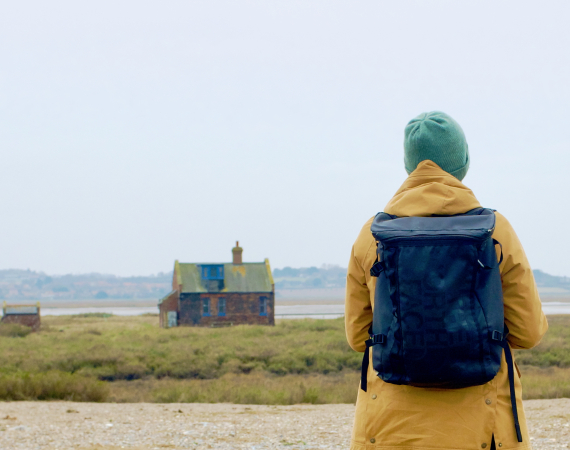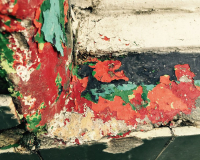Posted on Mon 5 May 2025
Writing Home
A reflection on home, and the ways in which research on Whiteness and R&D is unfolding into my wider work.

The author stands looking at a derelict house in the distance
Posted by
Project

Murmurations: a mutual research exchange
Research is an earth making practice. It is about recognising that what happens to others relates to what happens to us.In the last piece I wrote, I tried to answer a question that I was asked a long time ago about why I found it hard to talk about being White. I was nervous about publishing it but am glad that I did. My companion on this research journey, Dr Erinma Ochu, told me that writing is about relationships and this has become true for me - maybe I will say more about that at some point. In this piece though, I want to reflect on the ways in which my research around Whiteness and R&D is unfolding into my wider work as Executive Producer of Pervasive Media Studio. It’s a bit complex to do that because I am right in the middle of it, but I think that there might be some value to documenting things as I go. Here’s where I left off last time:
The active and ongoing effort is in figuring out, in loving solidarity, what I do to try and create a different kind of container for our work. A container that is expansive and porous, one which isn’t afraid to get complicated but where there is joy and laughter, one where people encounter lives different to their own and yet feel the truth of their connection, a space in which people are unafraid to build from what they feel as well as what they know and out of which strange and wonderful things emerge. I don’t know what those things might be, but that’s okay because the point is not to create a singular vision of the world – but to trust that we can make it together.
Home as container
We recently launched a new film and creative technology programme at Watershed - a year of making, watching and sharing ideas of Home. I have been leading the development of this theme, and trying to do so in a way that stays true to the intentions of my research.
We regularly have programming or commissioning themes at Watershed, they create interesting connections for our community of makers and for audiences. Often these are heavily informed by the policy agendas of funders, or the momentum of money being invested in a new technology. This has many benefits because we tap into a wider set of resources and momentum, but (while we work hard to find our own angle) it can make it difficult to avoid dominant ideologies framing our vision. We are usually asked to report on what we support via short term success indicators such as financial return, jobs created and products produced. This can mean that those whose work does not mirror these parameters (by necessity and/or design) are less well served. Our experience suggests that these are often Black, Brown and/or Disabled practitioners working deeply with communities, designing new approaches - bringing the methods, expertise and knowledge that are so urgently needed for change in a careworn world.
Reflecting on my initial thinking about the ways in which Whiteness uses up the world, I wanted to do things differently this year. So rather than turning to our funders, I started exploring themes through a series of conversations with the teams at Watershed, with members of the Studio community and with Erinma. I hope that this means that the programme itself will exist as something that Watershed do, but also as an emergent quality of the network - with no one expert at its centre, no particular agenda to serve, no external deadline to meet.
If you have privilege in an area, it's very hard to see what is lacking in that area. I get caught in this all the time. You have to cultivate relationships with people who can see more than you and who can see differently than you, so that together your co-imagination becomes something that actually works for everyone. adrienne maree brown
The idea of exploring Home came originally from Cèlia Domínguez Hernàndez in a discussion with Lawottim Anywar and Martin O’Leary about what our community seem interested in. We collected a list of creative projects that connected in some way to the different strands that surfaced. We shared our thoughts as an idea through small exchanges and larger convenings, testing it out with colleagues, partners, visitors and artists in residence. It seemed to resonate widely, eliciting a different kind of conversation (I’ll come back to this) and together (we set up a working group from across the organisation to steer the process) we decided to develop the idea into a public programme. Home has much less resource than other programmes we have run, which will limit us in some ways. But this lack of external funding also means that we can go more slowly, working with what we have and weaving things together rather than building something new. Allowing the complexity to spiral out and trusting that interesting things will happen.
Homesickness
If I have any agency, it is opened up by the fact that I am constituted by a social world I never chose. That my agency is riven with paradox does not mean it is impossible. It means only that paradox is the condition of its possibility. Judith Butler, Undoing Gender.
Building on my intention to examine my own Whiteness, I have been thinking about where I am from and the structures which have produced me. The idea is that in being more aware of my position within the matrix of domination, I am more able to avoid reproducing it. So alongside the collective element of the theme’s development I have spent a bit of time reflecting on my own sense of home. Before embarking on more conversations with people, it felt important to consider the questions that I knew we would be asking others. In this I seek to learn from the methods of Black feminist researchers like Patricia Hill Collins who assert ‘the need to reconcile subjectivity and objectivity in producing scholarship’ by understanding your everyday experience as part of a research process.
You can read some of this writing here. It is partial and incomplete and I find it a bit embarrassing (I grew up with the idea that it isn’t very polite to talk too much about yourself) but it is a useful record of something I am trying to practice.
This exercise told me things about the relationship between the family that I was born into and those that I have created since. It asks me to take responsibility for the stuff I can control and look with compassion and curiosity at the bits I can’t. It makes clear the socially constructed nature of my experience of home. I am taking an element of this approach into work with colleagues, inviting all Watershed staff to reflect a bit on their own homes, and share as they want to, before we take that conversation to audiences.
Making home
Home feels so relevant to my research because in its idealised version, it speaks to a feeling of belonging. In English the word references not just a physical space but a sense of ease, of being able to be yourself without judgement or persecution. This is a thing to seek out and bask in, and understanding what creates that for other people is a way of striving for justice. All of us have experience of creating home, but some people have the particular perspective and expertise born of creating space for themselves in surroundings where they don’t easily fit. Queer, Disabled, and/or migrant communities for example offer deep knowledge that I am keen to learn from in understanding home. As Sarah Ahmed reflects in Queer Phenomenology: Orientations, Objects, Others:
What I remember, what takes my breath away, are not so much the giddy experiences of moving and the disorientation of being out of place, but the ways we have of settling; that is, of inhabiting spaces that, in the first instance, are unfamiliar but that we can imagine—sometimes with fear, other times with desire—might come to feel like home.
I host a regular forum in the Studio called Community Conversations where we bring together residents to talk and listen around a subject of shared interest without expectation of outcome or agreement. This is part of an effort to imbue a sense of belonging at the Studio, enabling people to feel that they can share ideas and opinions without fear of repercussion. We have held two of these conversations recently around the theme of home. I have loved the ways in which the content and form have mirrored each other, the conversations becoming home-making exercises in themselves.
These conversations about home often turn towards discussions of power. Families are governed by small systems of power that define who does what work, what behaviours are acceptable, what bodies count. This reflects the structures of power that preside over our communities, societies, nations – defining citizenship in ways that render some people more valid than others. Sometimes that power becomes violent, making the place that we live (be it a house or a nation-state), unsafe for us to be. Sometimes it shapes us in ways that are bearable but do damage over time, leading us to forge new forms of home, make new kinds of kin.
Home as a space in our imagination or memory is a potent source of expression. So often in these conversations people have talked about home as a place far away, where they have family roots but have rarely, if ever, visited. Home is a story but home is also a material concern. A shelter from the world and its weather that some people have to excess and others can’t afford at all. People want to talk about the housing crisis and increased costs of living, about economic structures and the policies that reinforce them. There are also many people who spend more time at home than they would want to, because the rest of the world is not well designed for them or puts them at risk.
It was important to me that these conversations were hybrid – people joined us from elsewhere in the world, they brought their partners, their babies, their comfortable sofas. The physicality of this enmeshed professional and domestic space reflected the pattern of ideas we explored. Lucy’s mum and her telephone reminding Rachael of a study about wifi and wellbeing. Amanda’s understanding of the world-making nature of language connecting to Cèlia’s experience as an immigrant in the UK. Matthew’s furniture making practice speaking to Fozia’s weaving workshops. Posi’s philosophy of self prompting Martin to reflect on how we configure the objects around us. Jack’s more than human rhythms bleeding into Erinma’s sunset pram walks. And this tapestry of thoughts in turn reflects the truth that home is always personal and political, private and public.
Technologies of home
Understanding some of the ways in which home makes us, and that we make home leads me to return to ideas around technologies of solidarity. Often research and development around technology is focussed on moving faster, expanding further, developing big shiny things. We use bombastic pioneering language with all of its colonial implications of discovery and domination. And in this process, certain kinds of work, knowledge and bodies are diminished. As Catherine Knight Steele points out in her work on Digital Black Feminism ‘Society has separated ideas of home from work, ‘unskilled’ from ‘skilled’ labor, domesticity from technology’, devaluing the contributions of Black and Brown people, white women and low-income workers. What if thinking about technologies in relation to home offers us the opportunity to consider them as something much more intimate, relational and de-centralised?
Bringing home and technology into closer dialogue has got me and my team wondering about DIY cultures of making. Are there things that we could teach ourselves and learn from each other that would foster a really nourishing habitat? I got a sense of this potential in our Community Conversations. They have yielded insight into nomadic architectural practices and intergenerational communication, revealed digital spaces of resistance, connected us to the histories of our everyday things. They have brought practices of care, ways of gathering and new forms of communion into view as important domestic technologies.
We are now thinking about what all this means for the practical ways in which we support creative technology practice. What workshops will we hold for families and young people over the summer? What might our residencies look like this year? How might we enable people to make from and for domestic spaces?
Sometimes people at work ask me what a theme on home is for, what it will achieve and why we are doing it. As these notes show, home means many different things and prompts a lot of emotion. It feels so big, perhaps we need to narrow it down, decide what isn’t included? These are good questions, resources are scarce and we should ask each other why we make the choices we make. Our public programme will engage audiences in highly relevant issues around migration, displacement, climate change and inequity. Issues that I think people need a space to reflect on alongside each other. I hope that the theme will bring people together in new combinations, and that by listening to each other we will feel the ways in which we are all different and also the same.
For me the uncontainable nature of home as a theme is part of the point. The feeling of messiness has something to do with letting go of Whiteness as a categorising structure, of being open to other ways of organising life. And by drawing on the conversations that we have had so far, we might produce spaces, relationships and technologies that belong to us. That allow us to feel at ease, to know where we are from.
Community conversation participants: Lawottim Anywar, Martin O’Leary, Cèlia Domínguez Hernàndez, Fozia Ismail, Ayan Cilmi, Jane Gauntlett, Jonah Ling, Constance Fleuriot, Camille Aubry, Deanna Rodger, Matthew Merttens, Jack Lowe, Dave Evans, Emma Boulton, Erinma Ochu, Amanda Egbe, Lucy Reeves Khan, Nick Triggs, Olamiposi Ayorinde, Oluwatosin Olufon, Rachael Burton.
Watershed home working group: Bridget Hart, Claire Stewart, Kat Garoës-Hill, Isla Williams, Lawottim Anywar, Tony Bhajam, Steph Read, Amy Rose.
